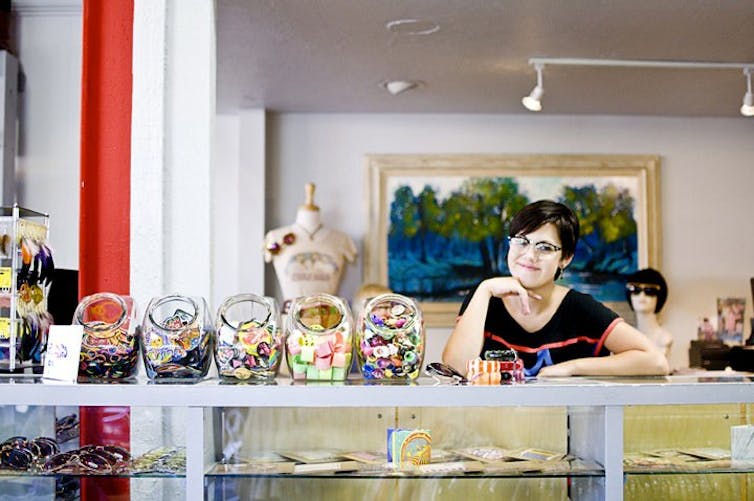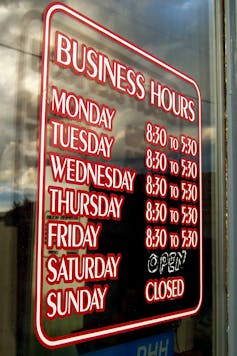The high street, or the main shopping area, has always been the heart of any UK town or city. But over the last ten years, it’s significance has dwindled. Over 28,000 stores have closed, and footfall has been on a “relentless downward trend”. While commentators often blame store closures on online shopping and poor footfall on the weather, our research uncovered a rather different problem.
Retail, society, technology and consumers are – and always have been – locked in continuous and interlinking cycles of change. This means a huge range of variables has affected shopping areas over the past 150 years. We put together a team from five universities, to find out what causes high streets to succeed or fail. Our findings from the High Street UK 2020 project identified 201 factors that influence the vitality and financial viability of the high street.
In fact, very few people go into town to visit one place; instead, the high street represents a whole bundle of benefits, including employment, education, healthcare, leisure, shopping, eating and drinking. So, for the location to be successful, the providers of these individual services need to work together effectively.
We found that the main reason high streets are struggling is that local councils and businesses have been slow to adapt to changes – they just don’t seem to be able to work and act together. Individual organisations were not used to collaborating, and wanted to know how, collectively, to improve their high street. Here’s what we suggest:
Closed for commuters. Image: mhofstrand/Flickr/creative commons.
1. Get the timing right
In our study, we identified 25 actions that will increase footfall on British high streets.
First, ensure trading hours meet visitors’ needs. Many shops and services are stuck in a nine-to-five trading pattern, which doesn’t reflect the time people want to use them – especially in places with many commuters.
2. Mix it up
Ensure the mix of retailers and other services on the high street is providing the right offering to consumers. Many shops complement one another: a single town may sustain a butcher, a greengrocers, a convenience store and a bakery, for example. But if any of these shut, it has consequences for other shops, as consumers see the individual shops as part of a package that collectively meets their shopping needs.
Our research shows it’s not just retail that consumers are looking for, so a thorough understanding of who’s using the town and why is key. But since landlords are free to let their properties to whomever they please, managing the overall offer of a location is challenging.
If visitors cannot satisfy their needs, all in one place, then they are motivated to find a new location. So it should come as no surprise that footfall in out-of-town retail parks has increased, as they diversify their offering, with bars, restaurants, cinemas and gyms.
3. Spruce up the street
The appearance of the high street is also important. Large projects such as street improvements and better lighting can attract more people.
But, it can be as simple as ensuring roads and pavements are clean. All too often, litter can blight the high street, putting people off coming, and businesses off investing.
4. Have a plan
There needs to be a cohesive vision and strategy for the location, shared by as many people as possible. This is how the local council, businesses, public services and local people can be encouraged to develop their piece of the overall offering in line with an overall plan, which outlines a realistic function for the high street.
Research by Manchester Metropolitan and Cardiff University has identified four functions for UK high streets, based on analysis of over ten years of hourly footfall data, supplied by Springboard.
Shopping is the main purpose in only about a quarter of UK towns. Other locations are centres of employment and drivers of the local economy, or serve the everyday community needs of locals, or attract day visitors or holiday makers, who may do some shopping, but are more interested in other things.
The businesses and decision makers in many town centres just do not know what function their town should be serving. A strategy can identify and communicate the purpose of a town, its aspirations and attract investment from both public and private sectors.
5. Service with a smile
These measures can help raise the quality of the high street experience. A customer’s positive experiences with several different retailers and service outlets can be completely negated by a surly taxi driver or a dark and foreboding car park.

A friendly face. Image: riversideavondale/Flickr/creative commons.
A quick review of Tripadvisor can identify problem areas, and a sense of collective responsibility, community or pride may encourage some operators to improve. Initiatives that improve customer experience across a whole town or city, such as mystery shopping, followed up by customer service training can also help.
Making it happen
We don’t underestimate the challenge ahead. All of these interventions require collective action and decision-making, which can be difficult, given the way most towns and cities are governed. Unlike in Europe, where town centres are managed in partnerships between local government and businesses, many places in the UK do not have this mechanism in place.
Collaboration is key to success, so new governance and management models are needed. Over 250 traditional retail areas in the UK have already voted to become a Business Improvement District (BID), where retailers pay an additional levy to fund exactly the type of initiatives identified by our research. Securing agreement for a BID gives all concerned the motivation and tools they need to work together.
![]() We expect more locations will adopt the Business Improvement District model, but they don’t have to. Most important is that people work together. No one developer, planning officer, retail manager, mayor, concerned citizen or market trader can change the fortune of their high street. So, we predict that people who have the skills to facilitate collaboration and coordinate local action will play a starring role in the next episode of the high street story.
We expect more locations will adopt the Business Improvement District model, but they don’t have to. Most important is that people work together. No one developer, planning officer, retail manager, mayor, concerned citizen or market trader can change the fortune of their high street. So, we predict that people who have the skills to facilitate collaboration and coordinate local action will play a starring role in the next episode of the high street story.
Cathy Parker, Professor of Marketing and Retail Enterprise, Manchester Metropolitan University; Simon Quin, Visiting Professor of Place Management, Manchester Metropolitan University, and Steve Millington, Senior Lecturer, Manchester Metropolitan University
This article was originally published on The Conversation. Read the original article.







